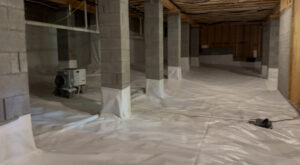The Dangers of Crawlspace Moisture

Where does Crawlspace Moisture Come From?
Ground soil exposed to the open air causes crawlspace moisture and humidity. Soil naturally retains water, and that water, unfortunately, isn’t exempt from the water cycle. Therefore, it eventually evaporates, and your crawlspace traps the resulting moisture. This process, combined with Arkansas’s humid weather, creates severe crawlspace moisture that can negatively impact your property’s health.
The Dangers of Crawlspace Moisture
1. Mold Growth & Wood Rot
A humid crawlspace is the perfect environment for mold to grow and prosper. Mold can pose many dangers not only to yourself, but to the structural integrity if your home. Mold has been known to trigger allergic reactions, cause respiratory problems, or worsen conditions such as asthma. Additionally, from a structural standpoint, mold can cause wood rot. Wood Rot eats away at wooden beams, floor joists, and other key structural objects. Aa a result, wood rot can severely damage the foundation of your home and cause issues such as sagging, cracked, or bouncy floors. Furthermore, mold and wood rot can severely devalue your property as it’s a key aspect of a home inspection.
2. Pest Infestations
Many pests, especially termites, are attracted to dark and humid crawlspaces. Making your unprotected crawlspace the perfect environment for termite colonies to thrive and cause extensive damage to your home. Moreover, other pests such as cockroaches, ants, and rodents also find a humid crawlspace to be the perfect living conditions. If left unchecked, these pests can breed and inevitably make their way into your home in search of food.
3. Increased Energy Bills
Crawlspace moisture can negatively impact your homes insulation system. Consequently, your home will struggle to stay cool in the summer and warm in the winter. This forces your HVAC system to work harder, meaning your stuck footing a higher energy bill year after year.
4. Decrease in Property Value
A crawlspace itself doesn’t directly impact the value of your property. However, the issues caused by a humid crawlspace are regularly seen as red flags by home inspectors and prospective buyers. Correspondingly, the longer humidity problems persist the worse the damage gets, which in turn makes any repair work more expensive.
What Can You Do About It?
Crawlspace Encapsulation
Crawlspace encapsulations can be a heavy investment. However, there is no better way to secure a crawlspace and ensure moisture problems are a thing of the past! Encapsulations involve taking a thick vapor barrier and covering the ground, walls, and piers of a crawlspace. This process ensures that no moisture from the ground gets into your crawlspace. Typically, encapsulations are combined with dehumidifiers and/or sump pumps to ensure all moisture and water is eliminated from the crawlspace.
Vapor Barrier
Vapor Barries are similar to encapsulations, but only cover the ground of the crawlspace. Additionally, they are not as tightly secured as Encapsulations and have the potential to move and become less effective over time. Nonetheless, Vapor Barriers are a cheaper and notably viable solution to preventing ground moisture from entering your crawlspace.
Sump Pump
Sump Pumps are the perfect solution for large amounts of water entering a crawlspace. Placed in a strategic location, sump pumps quickly and effectively pump water outside of your crawlspace. If you are dealing with drainage issues or standing water in your crawlspace, a sump pump could be the solution you’re looking for!
Mold Treatment
If you already have mold growing in your crawlspace, don’t worry, it is treatable! With a professional mold treatment, it is possible to remove existing growth, stop the spread of more, and mitigate any health risks mold can cause. Typically, we recommend mold treatments are combined with a vapor barrier or encapsulation to ensure it never returns.















































































